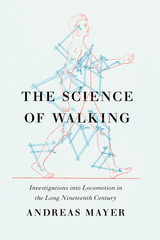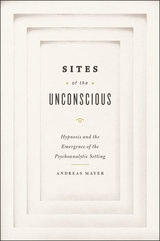2 books about Mayer, Andreas

The Science of Walking
Investigations into Locomotion in the Long Nineteenth Century
Andreas Mayer
University of Chicago Press, 2020
The Science of Walking recounts the story of the growing interest and investment of Western scholars, physicians, and writers in the scientific study of an activity that seems utterly trivial in its everyday performance yet essential to our human nature: walking. Most people see walking as a natural and unremarkable activity of daily life, yet the mechanism has long puzzled scientists and doctors, who considered it an elusive, recalcitrant, and even mysterious act. In The Science of Walking, Andreas Mayer provides a history of investigations of the human gait that emerged at the intersection of a variety of disciplines, including physiology, neurology, orthopedic surgery, anthropology, and psychiatry.
Looking back at more than a century of locomotion research, Mayer charts, for the first time, the rise of scientific endeavors to control and codify locomotion and analyzes their social, political, and aesthetic ramifications throughout the long nineteenth century. In an engaging narrative that weaves together science and history, Mayer sets the work of the most important representatives of the physiology of locomotion—including Wilhelm and Eduard Weber and Étienne-Jules Marey—in their proper medical, political, and artistic contexts. In tracing the effects of locomotion studies across other cultural domains, Mayer reframes the history of the science of walking and gives us a deeper understanding of human movement.
Looking back at more than a century of locomotion research, Mayer charts, for the first time, the rise of scientific endeavors to control and codify locomotion and analyzes their social, political, and aesthetic ramifications throughout the long nineteenth century. In an engaging narrative that weaves together science and history, Mayer sets the work of the most important representatives of the physiology of locomotion—including Wilhelm and Eduard Weber and Étienne-Jules Marey—in their proper medical, political, and artistic contexts. In tracing the effects of locomotion studies across other cultural domains, Mayer reframes the history of the science of walking and gives us a deeper understanding of human movement.
[more]

Sites of the Unconscious
Hypnosis and the Emergence of the Psychoanalytic Setting
Andreas Mayer
University of Chicago Press, 2013
In the late nineteenth century, scientists, psychiatrists, and medical practitioners began employing a new experimental technique for the study of neuroses: hypnotism. Though the efforts of the famous French neurologist Jean-Martin Charcot to transform hypnosis into a laboratory science failed, his Viennese translator and disciple Sigmund Freud took up the challenge and invented psychoanalysis. Previous scholarship has viewed hypnosis and psychoanalysis in sharp opposition or claimed that both were ultimately grounded in the phenomenon of suggestion and thus equally flawed. In this groundbreaking study, Andreas Mayer reexamines the relationship between hypnosis and psychoanalysis, revealing that the emergence of the familiar Freudian psychoanalytic setting cannot be understood without a detailed analysis of the sites, material and social practices, and controversies within the checkered scientific and medical landscape of hypnotism.
Sites of the Unconscious analyzes the major controversies between competing French schools of hypnotism that emerged at this time, stressing their different views on the production of viable evidence and their different ways of deploying hypnosis. Mayer then reconstructs in detail the reception of French hypnotism in German-speaking countries, arguing that the distinctive features of Freud’s psychoanalytic setting of the couch emerged out of the clinical laboratories and private consulting rooms of the practitioners of hypnosis.
[more]
READERS
Browse our collection.
PUBLISHERS
See BiblioVault's publisher services.
STUDENT SERVICES
Files for college accessibility offices.
UChicago Accessibility Resources
home | accessibility | search | about | contact us
BiblioVault ® 2001 - 2024
The University of Chicago Press









